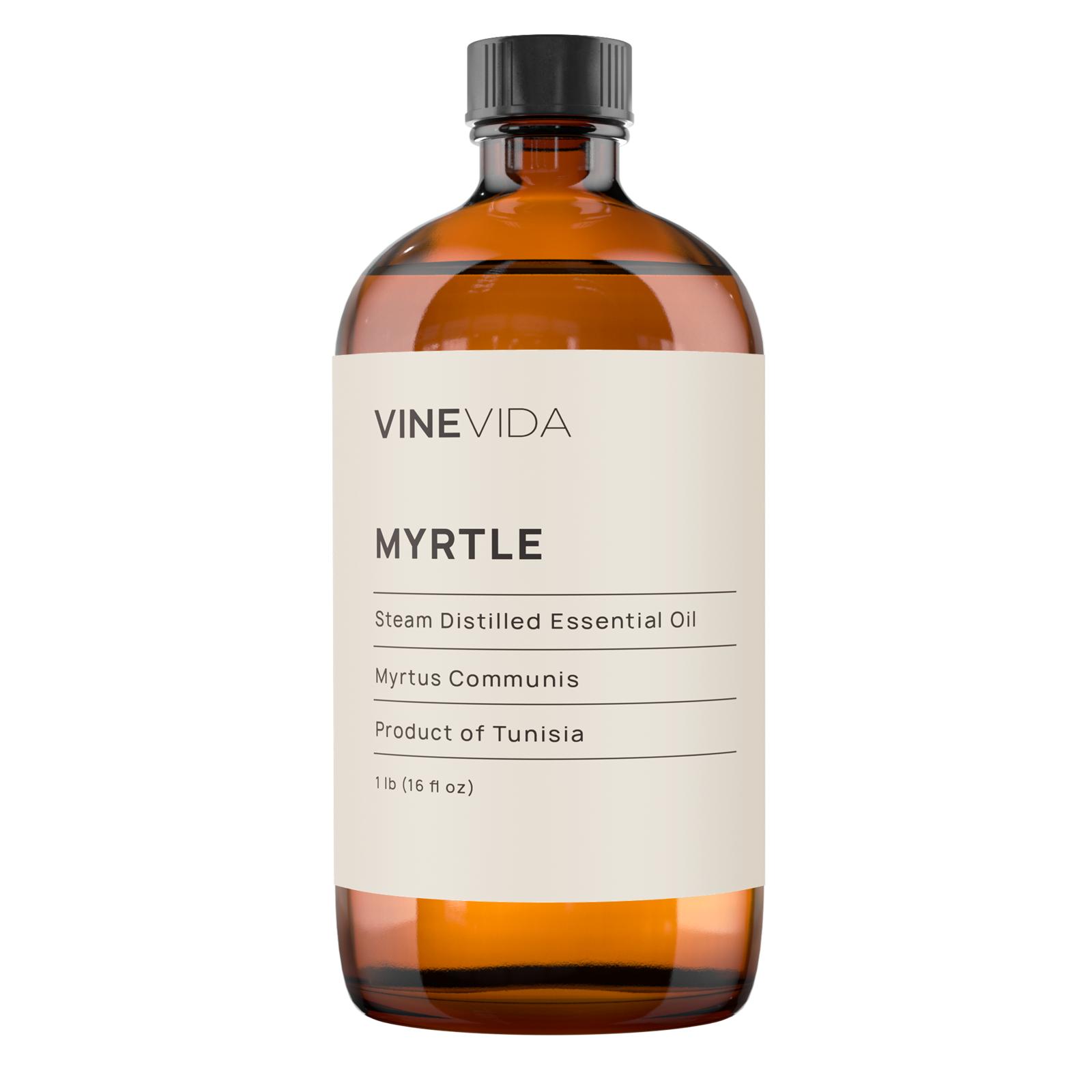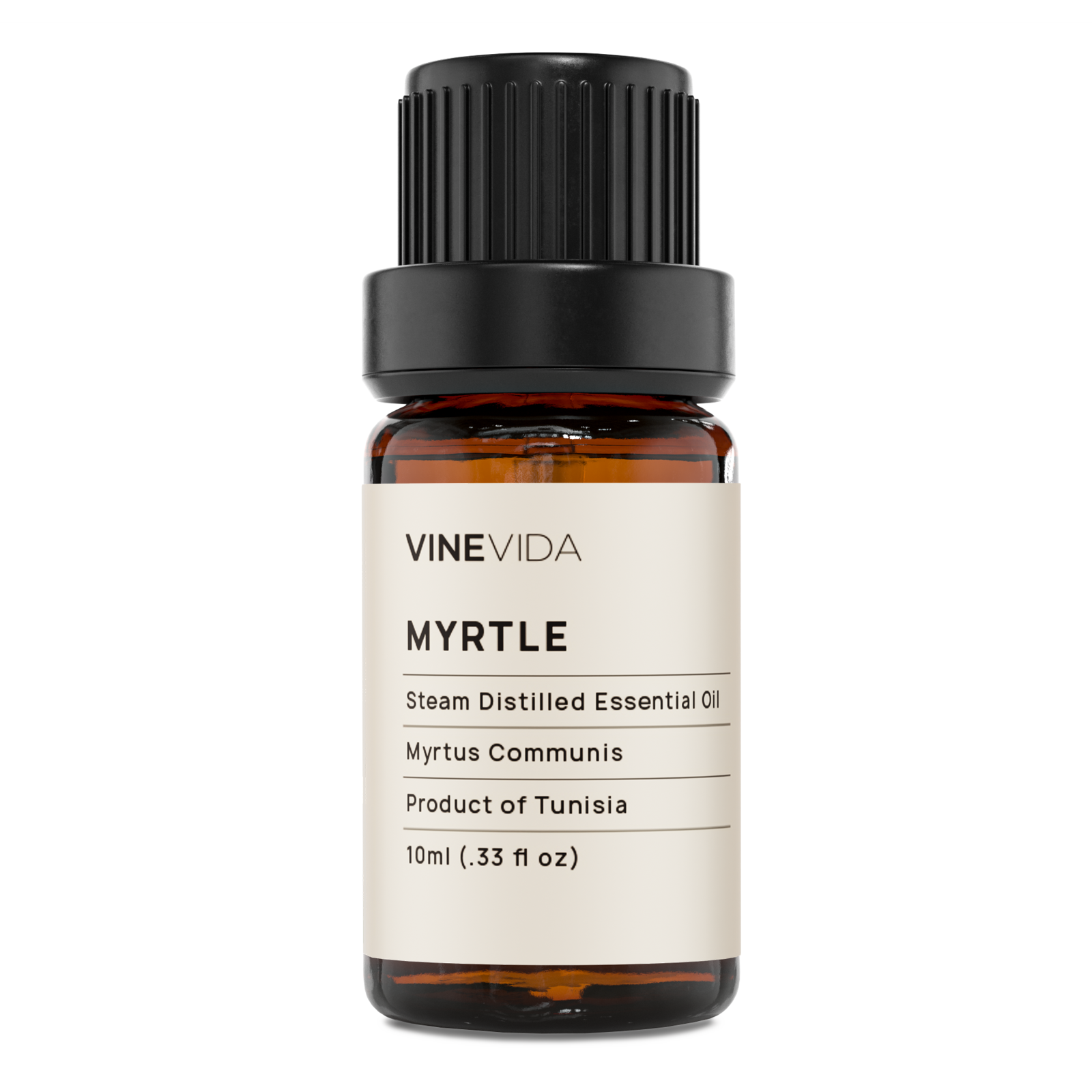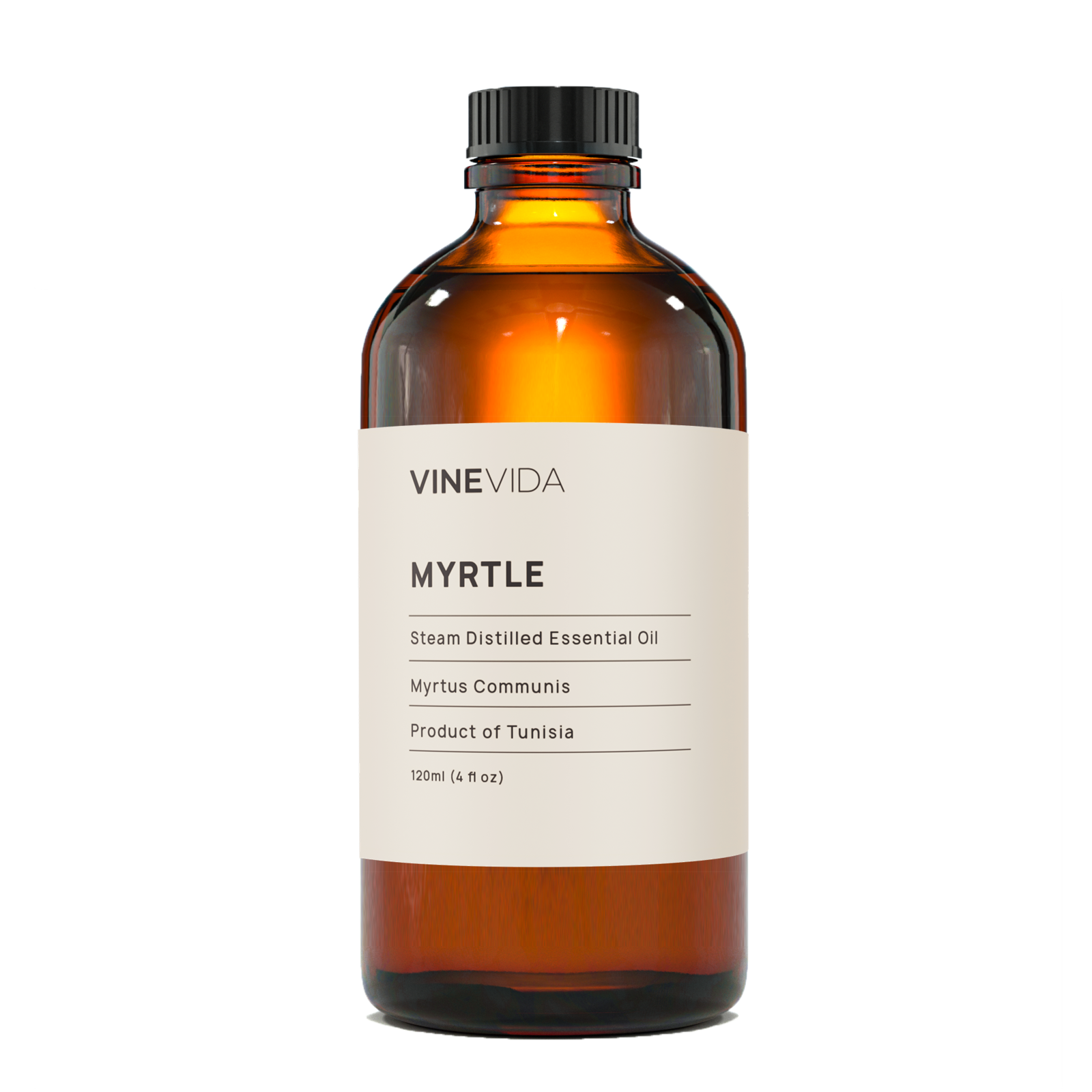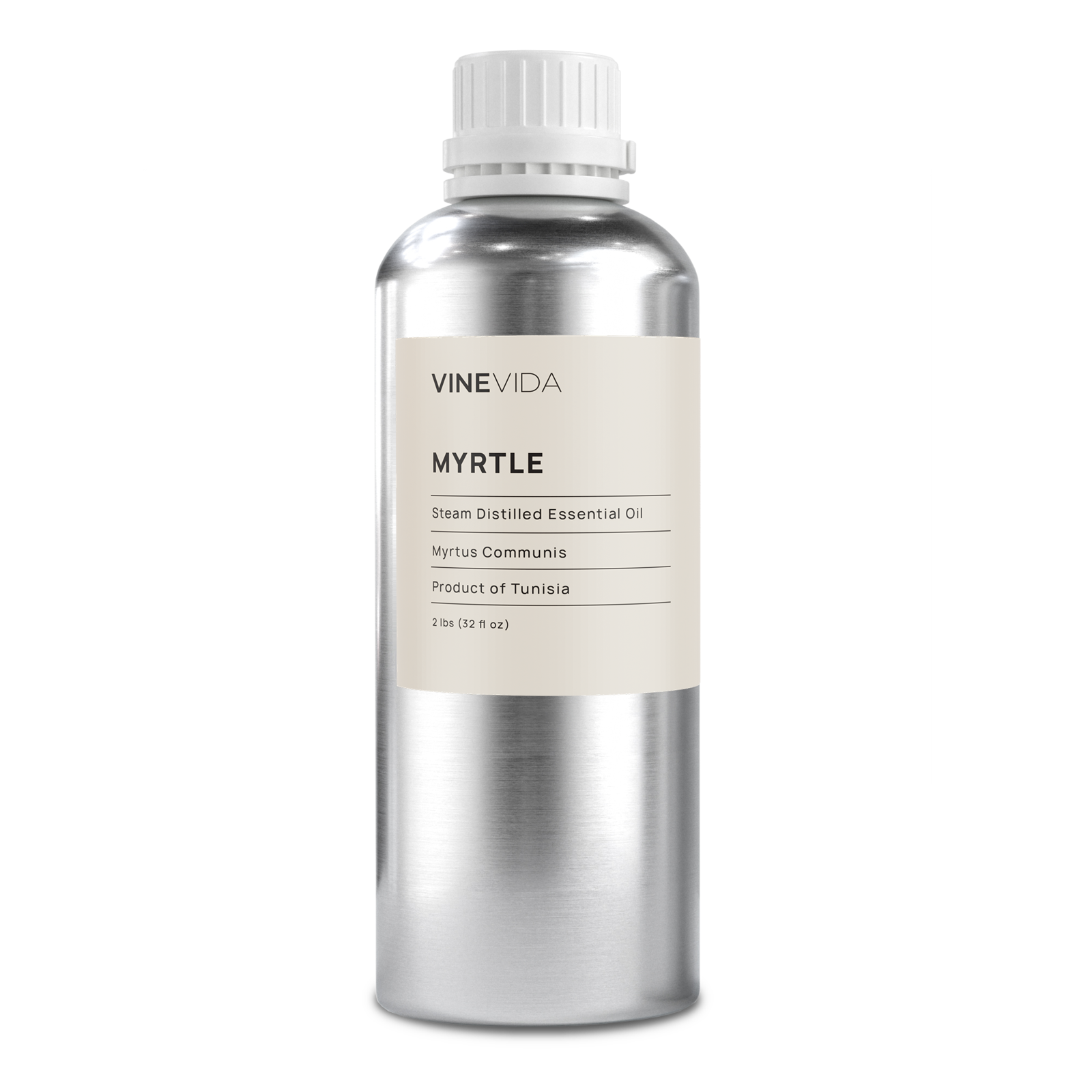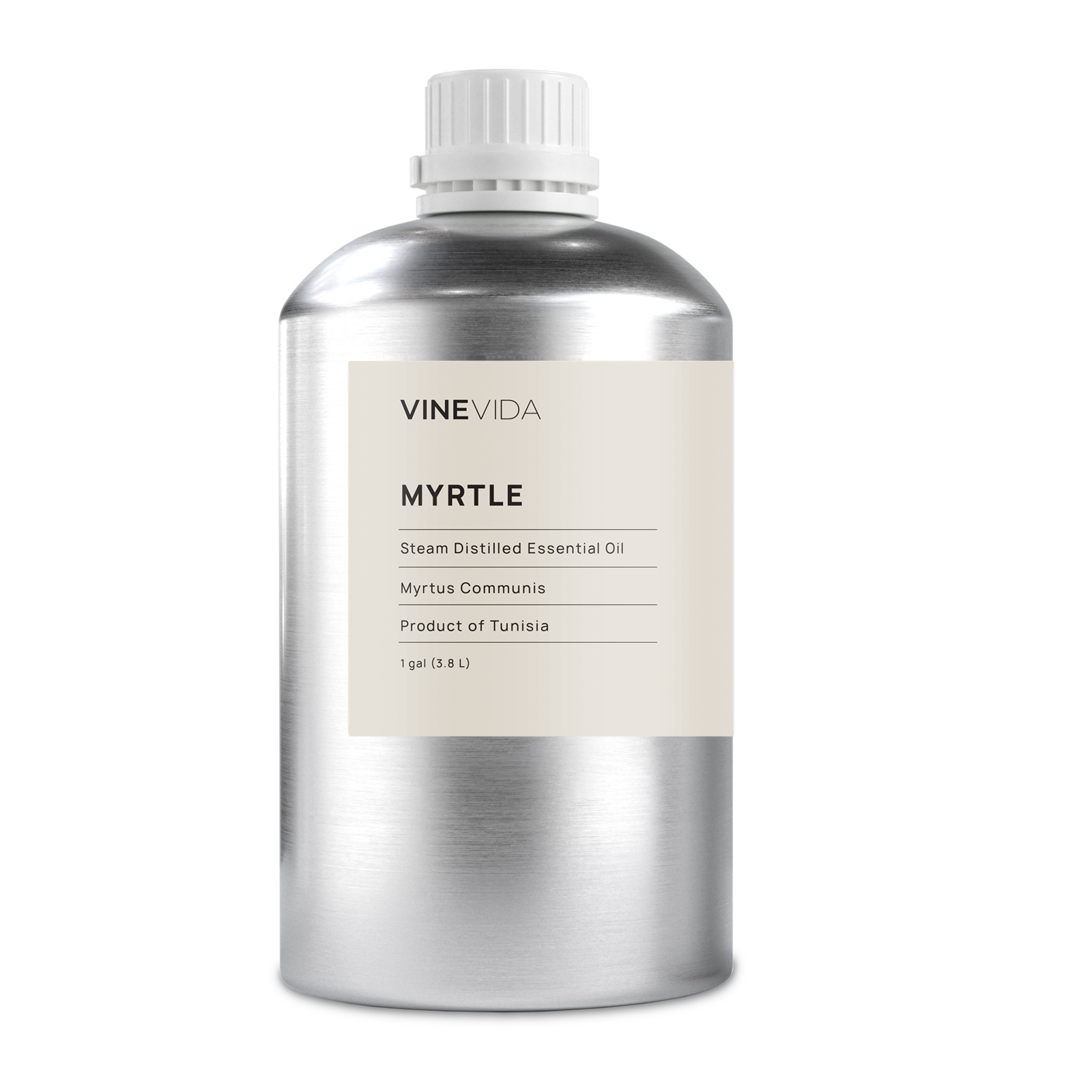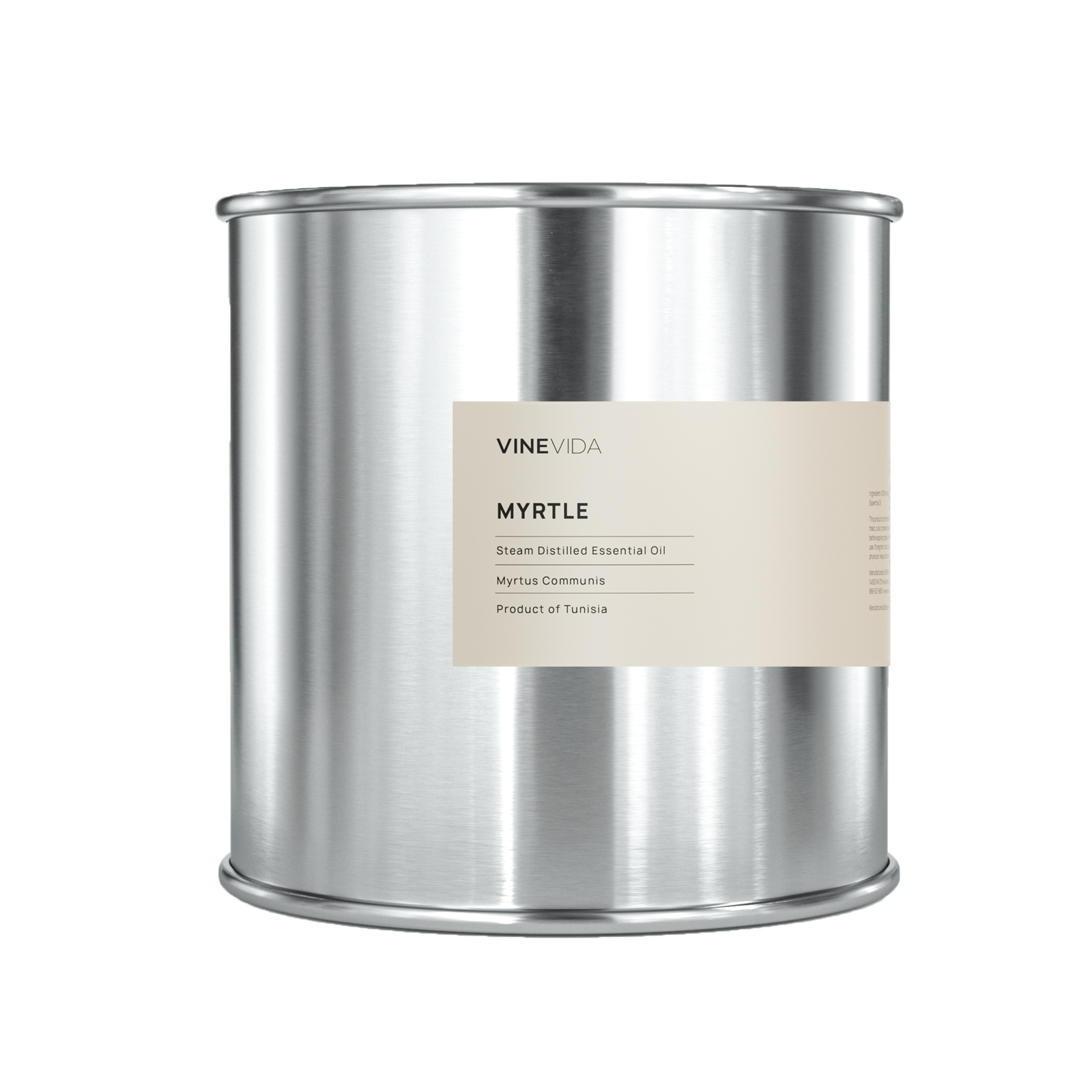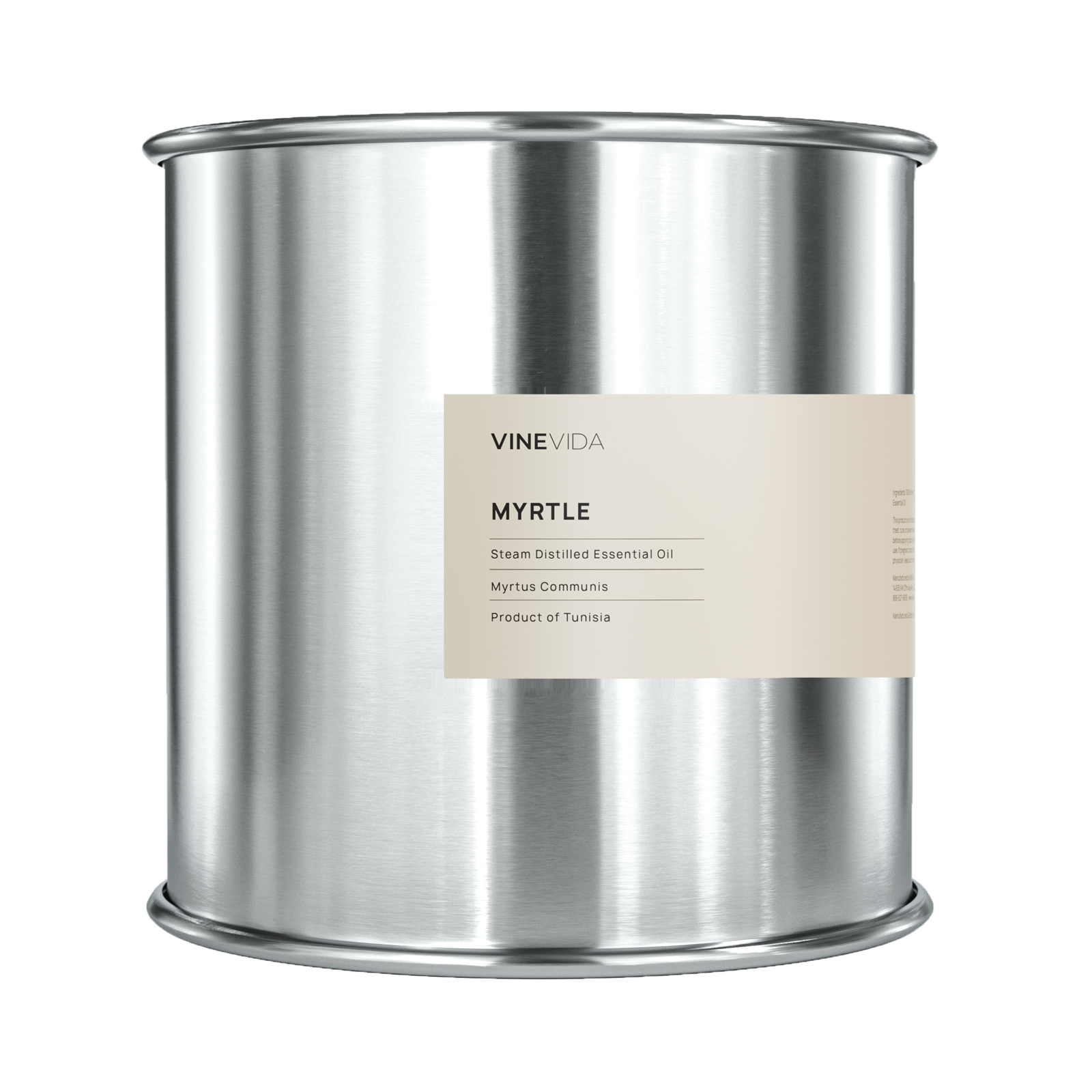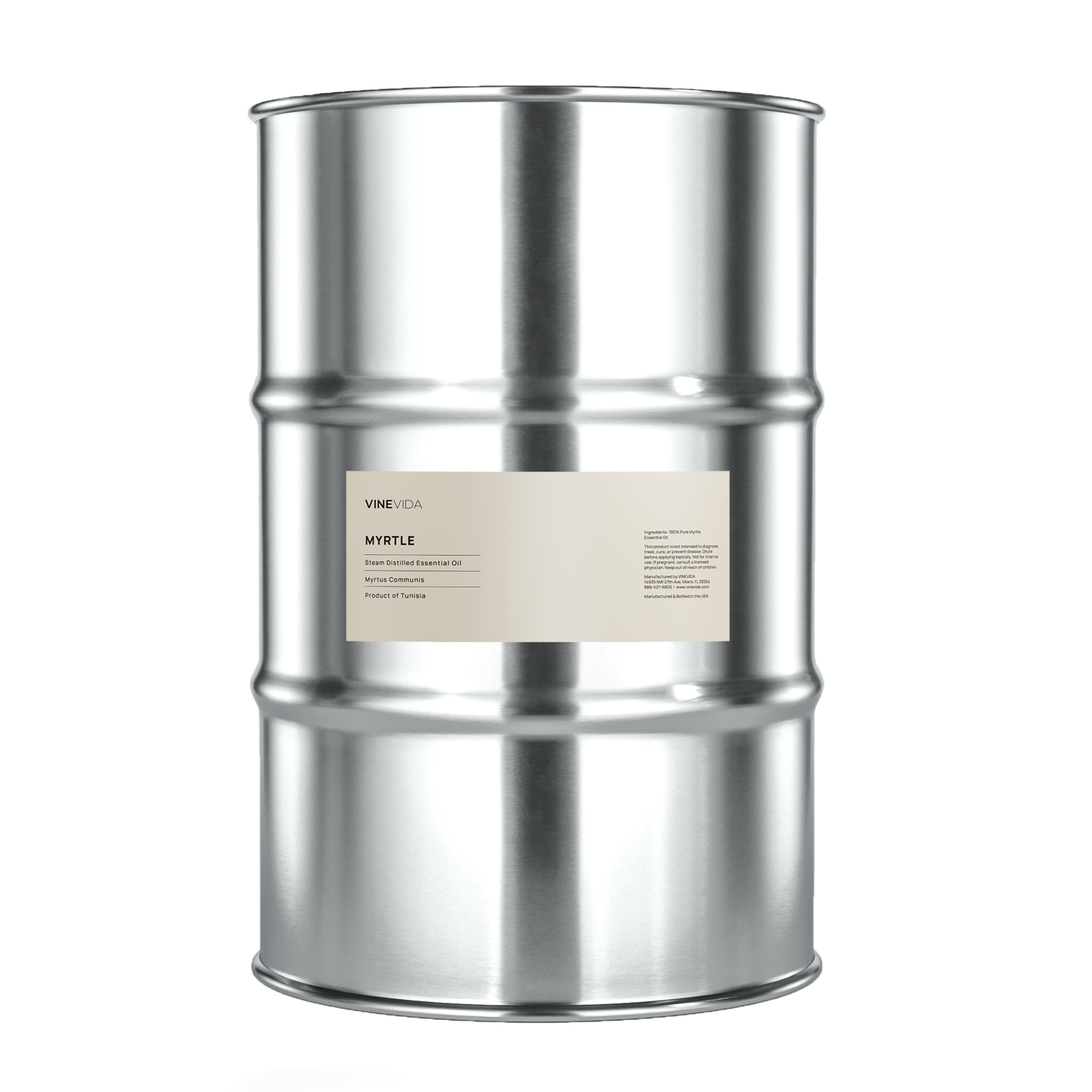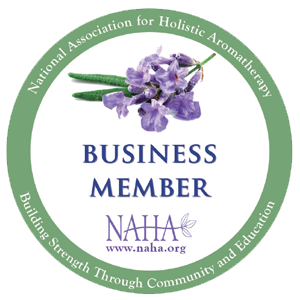Note: Before we start, there has been a huge boom in the number of Essential Oils coming out of Australia called myrtles, honey myrtle, lemon myrtle, pineapple myrtle…it should be noted these should not be confused with common all-garden Myrtle Essential Oil.
Scientific Name: Myrtus Communis
Origin: Tunisia
Plant Part: Leaves
Scent: Fresh, bitter, herbaceous
Color: Clear to pale green
Consistency: Thin
Perfumery Note: Middle to top
Initial Aroma Strength: Moderate
Extraction Method: Steam Distillation
Suitable Blending Oils: Clinical fragrances like eucalyptus and tea tree, herbs like lavender and chamomile, spices like cinnamon and clove.
Breaking Down the Myrtle Essential Oil’s Key Chemical Components
Common Myrtle (Myrtus Communis) is the only European member of the Myrtaceae family that includes tea tree, manuka, and kanuka in other countries.
Perhaps then the chemistry of Myrtle Essential Oil will come as no surprise.
- Alpha Pinene: 52.43%
- Limonene: 17.3%
- 1,8 Cineole: 10.69%
It is native to the Mediterranean area and has adapted well to the poor, dry soils found there. It is a small evergreen tree with aromatic pointed ovate leaves. Throughout the summer, the shrub gets covered in dainty five-petalled flowers which have dominant yellow stamens that bees adore. The leaves smell wonderful but have quite a bitter taste, which is well beloved in Middle Eastern cooking. Leaves are often placed into ovens where bread is baking, for example. Historical Uses of Myrtle Essential Oil Poor old Myrtle Essential Oil, J K Rowling did her no favors at all. Far from being “Moaning Myrtle”, Myrtle Essential Oil is loving, balanced, and incredibly powerful at taking care of our bodies.
When you look at the chemistry of Myrtle Essential Oil, it probably becomes more obvious why it was one of the most important plants of the ancient world. Native to the Mediterranean, and enjoying fragrance and evergreen leaves, it became an important ingredient for medicine and sacred rituals.
The first historical mention of myrtle appears in a recipe of plants that were used to please the Sumerian gods which dates to around 2100 BCE. Records show that stalks and leaves were burned to accompany incantations and sacrifices Eventually myrtle would become a symbol and beloved plant to invoke their goddess, Ishtar, and as such a mantle of the Divine Feminine.
Myrtle Essential Oil in The Ancient World?
Myrtle Essential Oil would not have been used in the ancient world, since we do not think distillation was invented until around the 12th century. Their medicines tended to be decoctions of the wood leaves and berries in wine, or the powder pulverized and made into a paste. So why are we interested in the history of how Myrtle was used?
Today, we are only just beginning to re-understand how the mind and body are related and thus how spiritual uses for plants can often influence the body too. The ancients always saw medicine this way, but sadly in most cases, the wisdom is lost. In Myrtle’s case though, there is a great deal of evidence left behind. Looking at the myths and legends of the past may help us understand more ways we can use Myrtle Essential Oil.
Since there is much to be learned from the spiritual significance of Myrtle Essential Oil, this is a long section. So, I’ll quickly outline the main uses for Myrtle Essential Oil, then you can look for the deeper ideas in the text.
Myrtle Essential Oil Uses and Benefits
- Astringent - wonderful for skin cleansing, especially for greasy skin and acne
- Antibiotic - Great if you cut yourself, but also for coughs and colds
- Respiratory Infections
- Genito - urinary infections
- Bleeding, especially bleeding hemorrhoids
- Antifungal - great for fungal nail infections
- Uplifting and soothing
- Cosseting and comforting
History of Myrtle in Ancient Greece
The ancient Greeks were fascinated by myrtle. Pausanius reports how it was sacred to both Aphrodite and Demeter. This may be because bees adore myrtle flowers and both of these goddesses were worshiped as bees and had priestesses who were called Melissae, bees. Myrtle is also sacred to Athena.
Myrtle trees were planted in all of Aphrodite’s sanctuaries and it is said that the name of the plant originates from the Greek word ‘myrtos’, which means “herb of love.” It is believed that they chose the word because it shared the same Semitic root as ‘myrrh’. (There is a myth that Aphrodite’s beloved Adonis was born of a myrrh tree).
Both myrrh and Myrtle Essential Oils are aromatic and used for purification and cleansing in rituals.
Myrtle Essential Oil and The Divine Feminine
A dream interpreter Artemidorus, described how "a myrtle garland signifies the same as an olive garland, except that it is especially auspicious for farmers because of Demeter and for women because of Aphrodite.” The olive branch is known to represent peace, victory, and prosperity.
Myrtle appears in many of Aphrodite’s myths. Some tellings of her origin story tell how, when she was born, she rose from the sea holding a myrtle leaf. Another tells how one day she visited the island of Cythera, but when she arrived naked she was confronted by a herd of lascivious satyrs so protected her modesty from leaves from a nearby myrtle. When he chose her as the most beautiful of all the goddesses, Paris crowned Aphrodite with a myrtle wreath.
Generalia
The Romans called Aphrodite, Venus, and celebrated an important festival on April 1st called Veneralia. Here Venus was celebrated in her guise as Venus Verticordia. Her job in this festival was to persuade married and unmarried Roman men and women of all classes to cherish traditional sexual proprieties and morality believed to please the gods and bring favor to the State. (Today we tend to use the word Venusian to describe matters of Venus, but their term venereal probably describes their concerns here best. Later you’ll see that Myrtle Essential Oil still pays testimony to their knowledge here .)
During this festival, her statue was carried from her temple down to the men's baths. There, her priestesses undressed and bathed her in warm water, before garlanding her with myrtle. Then, men, and women asked for help in affairs of the heart, betrothal, sex, and marriage. Then, their attention. was turned to the goddess Fortuna, whose job was to bring good fortune to women in marriage. To favor her, women bathed wearing myrtle crowns.
Aphrodite is often depicted as being surrounded by her attendants, The Charites who bathed and dressed her. One of these, Elias, holds a stem of myrtle with a rose in her hand.
Myrtle Essential Oil Stops Bleeding
Aristophanes tells how the victors of Theba Iolaea, (games held in honor of one of their heroes Iolaus,) were given myrtle wreaths to wear.
Iolaus appears in Greek mythology as one of the Argonauts and is credited for having helped Heracles overcome the mighty-headed hydra when he realized that chopping off their heads would not kill it. Instead, he cauterized the wound which then prevented the next head from growing back.
He was buried in Sardinia, where a temple was constructed in his name. Today, the National drink of Sardinia is a liqueur called Mirto which is made from the berries of a myrtle plant.
Myrtle Means No Blood is Lost
Hellotia was a torch race celebrated at Corinth to honor Athena as a goddess of fire. According to Seleucus, the festival derived its name from the myrtle garland which was carried about during the procession, which measured an enormous 20 cubits. (Perseus) (30ft)
The association with Athene may have come about because of a myth about Myrsine, a chaste girl whom the goddess Athena loved because she was such an incredible athlete. On one occasion, Myrsine even dared to compete and beat a man, which seemed outrageous to the other athletes, so they murdered her in vengeance. Athena blessed her body and turned her into a myrtle, which then also became sacred to her.
So then myrtle crows became a very important thing, signifying victory and accomplishment without bloodshed, (whereas war victories were signified by laurel.) They were awarded to the victors of the Olympic Games. Myrtle was so popular for feasts and ceremonies that market stalls were always reserved a space for its sale.
I rather like that Athena in her wisdom exacted the final retribution by forcing all competitors to always look up to the myrtle tree, placed on top of people's heads. It was also used for poets and as opposed to laurel wreaths, myrtle signified victory from a bloodless battle.
Myrtle’s Desire That Unnecessary Blood Should Not Be Shed
Myrtle is remembered at the shrine of Venus Cloacina. According to Livy, Cloacina was one of the epithets of Venus. The name derives from the verb "cluere" (to purify or cleanse).
Her shrine is related to the Roman-Sabine War. Pliny says that when it was built many myrtles were growing there. The Sabines were going into battle with the Romans in vengeance for the rape and kidnap of their women. Before going into battle, both sides laid down their arms and purified themselves with leaves from the many myrtle bushes that grew nearby. It’s not known if this is a myth or based in fact, but centuries later a coin from the region depicts one statue in the shrine holding a sword in one hand and a myrtle branch in the other.
In Virgil's Roman epic The Aeneid, the Trojan hero, Aeneas lands in Thrace looking to establish a new colony for his people. The land is overgrown and Aeneas works hard to clear it, pulling up plants and eventually, he comes to a mound where a myrtle bush is growing. He has just created an altar to worship the gods so he sees the opportunity to use the myrtle as a means of protection for the altar. But as he tries to uproot it, the branches spout blood and the plant begins to speak. It reveals that the mound is the grave of Polydorus. It is explained that Priam sent Polydorus to the Thracian king with protection money in case Troy fell. When it did, the king broke his contract with Troy and murdered Polydorus to please Agamemnon, pocketed the money, and kept quiet.
The spears that had slaughtered the messenger had transformed into the myrtle tree, and Polydorus forebodingly instructed Aeneas to leave this place.
The Mysteries of Myrtle Essential Oil
Myrtle played an important role in the protection and initiation of Demeter's Eleusinian Mysteries.
Initiates processed 14 miles from Athens to Eleusis carrying the state of Iacchos, the holy spirit of the Mysteries, crowned with myrtle. As they reached the sanctuary, they washed their hands in holy water and were each crowned with myrtle leaves. The Melissa priestesses, the Hierophant (who represented the creator of the world ) the Dadoukos (torch bearers who were the sun), Euphobium (the moon), and the Heiroceryx who represented Hermes, the messenger of holy tidings, all wore purple robes and myrtle wreaths atop their heads.
(Hard to know whether the fact that the Melissa High Priestess of Demeter held the most important seat at the Olympic Games, where the prize was a myrtle wreath is connected or not.)
What is interesting though is anyone could be initiated into the Mysteries (provided you could afford it, because it would have been a very costly endeavor). The Mysteries took place for around 2000 years, and later it became mandatory that you could speak Greek, but originally, the qualification was freedom from "blood guilt",] meaning never having committed murder.
Myrtle Essential Oil for the Dead
The Eleusinian Mysteries took place in the autumn and seemed to celebrate the grape and grain harvests. No one really knows what happened in the main ritual at Eleusis but we understand it may be something to do with the afterlife. This may tie in with Afghan and Iranian traditions that myrtle leaves can avoid evil eyes. Dry leaves are burnt and the smoke is, "ماڼو" (māṇo) is used to clear spaces of spirits.
Blessings of Paradise From Myrtle Essential Oil
In Jewish tradition, myrtle symbolism accompanies people from birth to death.
Sprigs of myrtle are often used to decorate the bed where a baby is born. One is placed on the cushion used at the British Milah circumcision ceremony.
In Jewish mysticism, the leaves of the Myrtle tree represent the masculine phallic energy in the universe, so Myrtle is given as part of bar mitzvah blessings and weddings.
Myrtle is also laid on the bed when someone dies. It is both a sign of purity and a totem of protection against impurity. In the Sephardic tahara, (a manual that teaches how to take care of the dead) Myrtle leaves were added to the water in the seventh and final rinsing of the head.
Myrtles are often used at the end of Shabbat for Havdalah, as well as for blessing a new home or opening a new business as a symbol of hoped-for success.
But why?
Well, to the Persians, Jews, and Arabs, myrtle symbolizes Paradise. When Adam was expelled from the garden, it was the myrtle that he asked for to remind him of the place, it is said to be the scent of Heaven (BhM II: 52; Sefer ha-Hezyonot 17). Ancient Egyptians, of course, had a different idea of what happened to the soul after death, but to them too, Myrtle was associated with the Otherworld, serving as a reminder of the eternal life of their souls.
Today, Myrtle Essential Oil is used in prayers and chants to commune with the souls of those who have left us and to explore previous incarnations in past life readings and meditations. It is excellent for dream work, divination, and prophecy and is often used as a gatekeeper oil to protect people while they are doing meditations or journeying.
Myrtle Essential Oil for Rest and Recovery
It often also signifies restoration and recovery when it is used in the Talmud. This may be because Myrtle grows happily in dry solid, it thrives along waterways, so it suddenly looks much more vibrant after a drink.
This idea of a connection between myrtle and vigor was even held at state and political levels. Pliny the Elder wrote: “For at the Temple of Quirinus, or, in other words, of Romulus himself, one of the most ancient in Rome, there were formerly two myrtle trees, which grew for a long period just in front of the temple; one of these was called the Patrician tree, the other the Plebeian. The Patrician myrtle was for many years the superior tree, full of sap and vigor; indeed, so long as the Senate maintained its superiority, so did the tree, being of large growth, while the Plebeian tree presented a meager, shriveled appearance.”
In later times, however, the latter tree gained the superiority, and the Patrician myrtle began to fail just at the period of the Marsic War when the power of the Senate was so greatly weakened and little by little did this once majestic tree sank into a state of utter exhaustion and sterility. There was an ancient altar also, consecrated' to Venus Myrtea, known at the present day by the name of Murcia. (Perseus)
Myrtle is a Sign That God has Intervened
It appears many times in Talmudic writings, and when it does, it signifies that something will improve because God has intervened.
For example, Isaiah prophesied that when the kingdom comes
“…instead of the brier shall come up the myrtle tree…” (Is. 55:13).
‘I will plant in the wilderness the cedar, the shittah tree, and the myrtle, and the oil tree’. (Isa. 41:19).”
The prophet Zechariah was thought to have been active around 520 BCE.
His visions were related to his belief that the Day of Judgement was near and that the Temple of Jerusalem needed to be rebuilt if his nation were to be saved.
He envisioned a visitation by the Four Horsemen of the Apocalypse.
I saw in the night, and behold, a man riding on a red horse! He was standing among the myrtle trees in the glen, and behind him were red, sorrel, and white horses. Then I said,
‘What are these, my lord?’
The angel who talked with me said to me,
‘I will show you what they are.’
So the man who was standing among the myrtle trees answered,
‘These are they whom the Lord has sent to patrol the earth.’
And they answered the angel of the Lord who was standing among the myrtle trees, and said,
‘We have patrolled the earth, and behold, all the earth remains at rest.’
Then the angel of the Lord said,
‘O Lord of hosts, how long will you have no mercy on Jerusalem and the cities of Judah, against which you have been angry these seventy years?’
—Zechariah 1:8-12 ESV.
The myrtle told him that what he was saying was a Holy place. Potentially, it was paradise.
Myrtle Essential Oil A Jewish Song of Righteousness
Myrtle is also used as a symbol of the righteousness of the kingdom’s blessing for Israel.
Myrtle branches were used in the construction of the booths during the Feast of Tabernacles, which looked forward to the coming of the Kingdom. (Neh. 8:15).
Thus Myrtle plays a part in the Jewish festival of Sukkot, which celebrates the Feast of Tabernacles. This takes place around the time of the harvest. Here, myrtle is one of four plants that represent different personality types in the community.
Myrtle represents those people who have never applied themselves to studies of the Torah, yet still work hard in the community.
Myrtle (or Hadass, as it is called ) appears in Leviticus 23:40 when it commands that the devout should obtain a lulav for the Sukkot holiday as a commemoration of the destruction of the Temple of Jerusalem. Myrtle branches are braided together with a willow branch and a palm leaf, then a citron is a fruit held in the other hand as part of the lulav wave ritual.
Myrtle Essential Oil for Peace, Prosperity, and Justice
Myrtle has three more meanings in Jewish symbolism, peace, prosperity, and justice.
The Hebrew word for myrtle is Hadassah (the Hebrew word for “myrtle.”)
This was the name given to the prophetess Ester who was able to persuade the Babylonian king to free the Jewish people. The Targums say: "They call her Hadassah, because she was just, and those that are just are compared to myrtles".
Interesting how Myrtle also seems to have a special relationship with those who give prophecies and oracles. Notice how it is a shapeshifter when you think how many times it has spoken to people or changed from one form to another.
Arabic folklore also has one of these tales. A knight named Rogero, rode his hippogriff, (a mythical flying half-eagle, half-horse), to an unknown shore. Upon landing, he tied the beast to a myrtle bush while he drank from a fountain. As he did so, a piteous voice called out from the myrtle. Untying his magical stead, the knight discovered that the myrtle and other trees were intrepid French explorers who had been transformed by the sorceress, Aleina. Rogera finally vanquishes Aleina’s evil hex with a good magic spell to restore the heroes to their human forms. (Notice the theme of water making them speak and them being associated with good)
Romance and Beauty with Myrtle Essential Oil
We’ve seen why myrtle is included in Jewish bouquets, but this is also a general European custom.
Mean Markle, the Duchess of Sussex had myrtle in her bouquet and the media went wild with a tale that a sprig had been planted in the ground at Osborne house on the Isle of Wight from Queen Victoria's wedding bouquet, and that sprigs from it had always been included in royal wedding bouquets since. However, according to studies done by the Smithsonian, Queen Victoria only had orange blossoms in hers. That said, myrtle is extremely easy to propagate from cuttings.
I rather love that the Romans point blank refused to have Myrtle in their bridal bouquets since Aphrodite had such a reputation for infidelity!
Myrtle Essential Oil For Libido
Despite the Roman disdain for how Aphrodite didn’t seem to be able to contain herself, Myrtle often appears in Roman recipes for love potions because its uplifting scent stimulates the senses.
Medieval herbals recommend rubbing myrtle leaves over the body to raise libido, particularly for women.
Myrtle Essential Oil For Skin Care and Beauty
Flowers and leaves were used to scent soaps and toiletries. Myrtle Essential Oil has good deodorant properties and is commonly used in eau-de-colognes.
In the 16th century, the rich and the good pampered the skin with a tonic called ‘Angel’s Water’, which was Myrtle Essential Oil with rose and Neroli Essential Oils and ambergris.
Myrtle Essential Oil is regenerating, astringent, and anti-allergenic. It is especially good for acne and oily skin, but can also be used on drier skin to deal with open pores.
Modern Evidence for Myrtle Essential Oils and Skin Care
In 2018, a wonderful trial done on Korean women assessed the effects of Myrtle Essential Oil on acne. The trial contained 20 women with acne who were not treating their skin problems in any other way except for the prescribed skin care in the trials. Ordinarily, the doctor might prescribe either antibiotics or a pill to try and stabilize acne, but for many people, these can be problematic. Hormonal changes can make the skin very flushed and more sensitive. Chemical cleaners can cause itching, and any way to avoid using antibiotics in the wake of antibiotic resistance is seen as good.
Acne can be caused by a variety of problems, increased sebum accumulating in hair follicles, thickening and hardening of dead skin cells inflammation, etc.
Myrtle Essential Oil is a wonderful choice for acne because it is rich in esters, a particularly gentle chemical group on the skin. (Battaglia 1997).
In this study, the women were split into two groups. They were each treated once a week with an algae masque and were also given creams to use at home. These were a foam cleanser, toner, moisturizer, and a sunblock.
The experimental group had Myrtle Essential Oil added to each of their treatments. The control group did not.
They had their skin condition measured before the study began, at 3 weeks after, and 6 weeks after.
The condition of their acne was assessed, how many skin cells had been removed, the condition of the redness of their skin, and how many micro-organisms were inhabiting the skin surface.
The Myrtle group showed improvement in all categories. (Kim, 2018)
Myrtle Essential Oil is also active against Herpes Simplex 1 (Owlia, 2007)which causes cold sores.
Myrtle Essential Oil and Hair
The stripping down of the skin of the complexion and its cleanliness may be down to its high levels of salicylic acid. These can also be helpful against dandruff and scaly scalps.
Myrtle Essential Oil and Headlice
Battaglia writes that the oil of myrtle is also proven effective in treating head lice and their eggs.
Myrtle Essential Oil and The Respiratory System
Using Myrtle Essential Oil as an inhalant may aid congestive conditions of the upper respiratory tract, such as bronchitis, chronic cough, tuberculosis, colds, flu, and infectious illnesses.
Over the next few sections, we’ll see how Myrtle Essential Oil has tremendous antimicrobial and bactericidal actions. Much of that can be attributed to the richness of alpha-pinene and 1,8 cineole.
These make Myrtle Essential Oil a fantastic oil to diffuse in the autumn and winter months to protect against cold and flu symptoms or to use as a chest rub or inhalation if you are unlucky enough to develop symptoms.
It has the most wonderful expectorant action helping to reduce coughing and to dispel phlegm. Myrtle Essential Oil is the best choice if you are coughing up blood.
It has enough 1’8 cineole to be useful, but not enough to prevent you from using it on children. It has a mild nature and a not unpleasant smell, which kids seem to like.
Because it is gentle and soothing, it makes a really good nighttime oil, whereas eucalyptus can be a bit stimulating for bedtime.
Aromatherapist Patricia Davis advises that Myrtle Essential Oil is “a good oil for elderly people both as a treatment and a preventative measure against chest infections’. (Davis, 2005)
An Ancient Insight in Myrtle for the Lungs
John Henry Clark was an important homeopath at the turn of the 20th century. He wrote how homeopathic treatments of myrtle have been able to do miraculous things for the lungs and particularly for chest pain, bringing about the breathing problems that accompany syphilis and tuberculosis.
This is not the same as Myrtle Essential Oil, but I thought you might find it interesting to see nevertheless since it would imply that Myrtle Essential Oil may also be useful for the same.
He suggests Myrtle for
- Pain in the upper left lung going right through from the front to the left scapula.
- Cases of phthisis which is the wasting disease that accompanies TB
- Hemoptysis (Coughing up blood)
- Hepatisation (when blood tissues and inflammation accumulate in the lung to make the tissue appear as if it were the liver)
He describes how the pain would be mostly like having the stitch, but could also be aching, throbbing, or burning sensations.
It is better in the morning, and worse in the evening, exacerbated by coughing, yawning, and breathing.
The cough is dry and tickly and sounds, hollow;
Also describes how myrtle has been useful for catarrhal fever with tickling cough, as well as coryza which is inflammation in the mucus membranes of the nose in conditions like hay fever.
Dryness in the throat accompanied by pains in the throat and chest and coughing up blood.
Catarrhal fever where there is also pain in the elbow and knee joints. (Clarke, 1902)
The Difference Between Myrtle Essential Oil and Homeopathic Myrtle
(There are many ways that homeopathy and aromatherapy are different, but the main one is that in aromatherapy we would use Myrtle Essential Oil which is an incredibly concentrated liquid extract of the plant. In homeopathy, they have a very dilute solid extract of myrtle. The more dilute the extract is, the stronger the effects are deemed to be. The standard dosage in homeopathy is 1/15th concentration.
Myrtle Essential Oil Protects the Lungs
Pulmonary fibrosis happens when lung tissue is damaged and scarred. Because this new tissue is much stiffer than it could be, it is harder for your lungs to work properly than it should be. As pulmonary fibrosis worsens, patients become progressively more short of breath.
An Iranian trial done in 2018, proved that myrtle extract (not quite the same as Myrtle Essential Oil, but close enough) reduced inflammation and fibrosis in the lung parenchyma which is the portion of the lungs involved in gas exchange. (Fekri, 2018)
Myrtle Essential Oil and Pleurisy
Schnaubelt recommended it with cypress Essential Oil for Pleurisy. There is no clinical evidence that myrtle can reduce the inflammation associated with pleurisy through a novel constituent called Myrtucommulones.
Antispasmodic Action of Myrtle Essential Oil
Part of the pain from pleurisy comes from how the lung tissues contract as you breathe and cough. Therefore the antispasmodic action of Myrtle Essential Oil is very helpful.
A trial done in Pakistan wanted to understand why and how Myrtle Essential Oil is so good as an antispasmodic agent.
Using a methanol extract (rather than Myrtle Essential Oil) they were able to show that myrtle alters the way the calcium channels work. Calcium channels are responsible for making tissues contract. (as in making the heartbeat, stomach cramps, leg spasms, etc)
The calcium channels also influence bronchodilation (making breathing easier by relaxing the muscles in the lungs and widening the airways) and vasodilation (dilating blood vessels). (Janbaz, 2013)
Myrtle Essential Oil and The Effect on Blood
So, think back to the mythology and how the Argonaut Aenaeus was associated with myrtle (the myrtle tree spoke to him) and he killed the hydra by cauterizing the wound.
He stopped bleeding…
We’ve already discussed how Myrtle Essential Oil may affect the calcium ion channels that influence the blood vessels.
Aromatherapists often use Myrtle Essential Oil for heavy periods and especially for uterine fibroids. Traditional Unani medicine uses myrtle to stop bleeding from hemorrhage.
An Iranian team, in 2020, suggested that myrtle be further explored as a hemostatic agent (stops things bleeding) because they had proved that it affected platelet aggregation activity. This activity gathers up platelets so they form blood clots and then scabbing. (Ebrahimi, 2020)
Myrtle Essential Oil for Hemorrhoids
Iran again, this time, in 2020, and a document review was done on the successes achieved in studies treating hemorrhoids with Myrtle Essential Oil (Yes, actually Myrtle Essential Oil this time, thank goodness, and it was human bums too!)
The results showed that lotions and ointments containing myrtle Essential Oil can improve bleeding, pain when the patient was going to the toilet, anal itching, and irritation. (Mahboubi, 2020)
Myrtle Essential Oil for Gingivitis, Pyorrhea / Periodontitis
Myrtle is used in Ayurveda to prevent bleeding from gum disease. We have seen how it can act upon the blood vessels but is also an extremely strong antimicrobial agent. (Ali, 2017)
Anti-inflammatory Abilities of Myrtle Essential Oil
Rodent trials show that Myrtle Essential Oil can reduce the inflammatory markers that are recruited to the site of injury, specifically interleukin 6 and Tumor Necrosis Factor -α Sage Journals.
Myrtle Essential Oil for Sexual Health
Interesting to see just how clever Myrtle Essential Oil can be for sexual health when you think that it was sacred to Aphrodite, the goddess of Love and Sex.
In 2016, a study was done on women visiting a gynecology ward in Iran to be treated for Bacterial Vaginosis (BV).
BV happens when there is too much of certain bacteria in the vagina. This alters the normal bacterial balance.
Symptoms of BV are vaginal discharge that can either be white or gray, accompanied by pain and itching in the vagina. It can also be uncomfortable to urinate. It’s not understood why, but BV increases your chances of contracting STDs like chlamydia and gonorrhea, or contracting and spreading HIV. BV can also cause pelvic inflammatory disease.
The group of 80 married women aged 18-40 years split into two groups. One group was treated with Metronidazole gel, an antibiotic used to treat a wide variety of infections. It works by preventing bacterial growth.
The second group had a 2% dilution of Myrtle Essential Oil added to their gel.
There was a significant difference in the results of the treatment between the two groups.
The results demonstrated that the combination of metronidazole and Myrtle Essential Oil was much more effective. Perhaps more importantly the patients receiving M. communis in metronidazole gel base did not experience any recurrent BV, but 30% of the patients who had just metronidazole had flare-ups after three weeks of follow-up. (Masoudhi, 2015)
Myrtle Essential Oil and STIs
Cervicitis is an irritation or infection of the cervix. It can be caused by sexually transmitted infections. Symptoms may include p discharge, pelvic pain, bleeding between periods or after sexual intercourse, or urinary problems. (Nabimeybohdi, 2019)
Traditional Iranian medicine uses myrtle fruits and leaves. The scientific trials have been done with a methanolic extract, rather than Essential Oil, however, the suggested active constituents are also found in Myrtle Essential Oils but the science suggests that Myrtle Essential Oil could also be helpful. The effects seem to be down to the potent anti-inflammatory action. Trichomoniasis is a common sexually transmitted infection caused by a parasite. It causes vaginal discharge, genital itching, and painful urination for women. (Men tend not to have symptoms)
The effects of the Myrtle Essential Oil and methanolic extract on Trichomonas vaginalis were also demonstrated by Abdollahy et al. (Abdollahy, 2010)
Antifungal Effects of Myrtle Essential Oil
Myrtle Essential Oil also has powerful antifungal properties, especially against candida albicans, the infection that causes thrush. (Torabi, 2022)
Myrtle Essential Oils are active against Trichophyton rubrum, which causes Athlete’s Foot.
Also, the Epidermophyton Floccosum populates to form skin and nail infections.
Microsporum canis is a skin fungus that forms in humans, cats, and dogs.
Cryptococcus neoformans is a yeast that is harmful to immune-compromised people.
Myrtle Essential Oil for UTIs
The Essential Oil’s antiseptic and bactericidal properties help treat urinary tract infections when used in a sitz bath or douche. (Battaglia, 1997)
The Digestive Native of Myrtle Essential Oil
Myrtle Essential Oil is a lovely treatment for poorly tummies, and because it is so gentle, it’s a great tonic for kids.
Again, we can see its influence on mythology. In the second century, Polychromos told the tale of Herostratus, a trader who sailed to Naukratis via Paphos in Cyprus where he bought a statuette of Aphrodite from the goddess's temple. This transaction proved to be fortuitous, for when the ship was caught in a storm, the sailors turned for safety to Aphrodite's statue. The goddess performed a miracle and saved the crew. The statue began to sprout myrtle branches and these in turn emoted the aroma of Myrtle Essential Oil that soothed the sailors' sea sickness and helped them make it to shore.
The Antidiabetic Properties of Myrtle
Researchers wanted to understand how herbal medicine had such good effects treating diabetes with myrtle leaves.
In this rodent trial, they used an ethanolic extract (rather than myrtle essential oil) on rats who were given a drug called streptozotocin that causes hyperglycemia (raised blood sugar).
They were given the Myrtle treatment before their streptozotocin then again 24 hours after and and 30 hours after.
The myrtle prevented the hyperglycemia from developing until 48 h after and significantly reduced the hyperglycemia altogether.
What’s interesting is that the Myrtle had no effect on the blood glucose level of the mice with normal blood sugar.
(Incidentally, the rats also had the myrtle treatment injected into their bellies so this would be another way that aromatherapy would be different because we would use the Myrtle Essential Oil topically and allow it to absorb through the skin). (Elfelah, 1984)
The Emotional Aspects of Myrtle Essential Oil
Myrtle Essential Oil makes you feel cared for. The Druze are an ethno-religious group found mainly in Syria, Lebanon, and Israel. It has around one million adherents worldwide. Followers emphasize Abrahamic monotheism but consider the religion as separate from Islam. (Harvard Divinity School)
They use the Arabic term “To myrtle” which means something akin to how you care for a child.
Myrtle is also used as an important part of circumcision, partly because of its innate symbolism but also because it stops bleeding. Myrtle powder is given to mothers on the birth of their new child. It is a costly gift because pulverizing the dried leaves is such a painstaking endeavor. The grinding is called “myrtling” and the women who do it are known as “myrtlers.” These women are seen as skilled wise women and are revered within their community.
So “to myrtle” means to grind the powder but then also to treat someone with it. It is usually done by groups of women who are close to your family.
“Did your mother myrtle you?” means: “Did she cosset you and invest time in your education.”
I love the scolding: “She got tired in your myrtling” This means she spent ages making that powder for you because she cared for you and now how do you repay that? You have a debt to be paid till the end of her days.
This is a very telling tradition since Myrtle Essential Oil does make you feel like someone is really taking care of you. It is recommended for people who have gone through some kind of trauma and for children who are very upset.
Other Emotional Uses for Myrtle Essential Oil
Myrtle Essential Oil is wonderful for self-destructive tendencies and feelings of hopelessness.
Is Myrtle Essential Oil Safe To Use?
According to Tisserand and Young, the maximum dilution of Myrtle Essential Oil is 1.9%.
If you are using in children, use in dilutions of not more than 0.5%.
Not suitable for use in the first 16 weeks of pregnancy.
DIY Myrtle Essential Oil Blends
Myrtle Essential Oil Blend for Heavy Periods
- 50 ml Rosehip Carrier Oil (Rosa Rugosa)
- 25 drops Myrtle Essential Oil (Myrtus Communis)
- 10 drops Jasmine Absolute (Jasminum Grandiflorum)
- 30 drops Clary Sage Essential Oil (Salvia Sclaria)
Method of use: Massage over the pelvis twice a day for three months.
Safety: Moot point, but not suitable for use during pregnancy.
Myrtle Essential Oil Blend for Digestion
- 5ml Grapeseed Carrier Oil (Vitus Vinifera)
- 3 drops Myrtle Essential Oil (Myrtus Communis)
- 3 drops Cardamom Essential Oil (Elettaria Cardamom)
- 3 drops Carrot Seed Essential Oil (Daucus Carrota)
Method of Use: Massage on the abdomen three times a day until symptoms subside.
Safety: Not suitable for use in the first 16 weeks of pregnancy.
Diffuser Myrtle Essential Oil Blend for Emotional Distress
- 1 drop Myrtle Essential Oil (Myrtus Communis)
- 1 drop Roman Chamomile Essential Oil (Anthemis Nobilis)
- 1 drop Spearmint Essential Oil (Mentha Spicata)
Why Choose VINEVIDA
At VINEVIDA, we love botanicals and the planet they come from. We believe in stocking the best at affordable prices and supplying to the discerning, which is why we are also members of both the Alliance of International Aromatherapists and the National Association of Holistic Aromatherapy. In recognition of our excellent standard of product, we are proud to hold a 2021 Certificate of Registration as a Cosmetic Products Establishment with the U.S. Drugs and Food Administration.
Our joy at seeing people make beautiful things means we stock from the smallest amounts to the largest. Our bulk Essential Oils’ prices begin with our smallest Essential Oil of 10ml to our largest of 396lb, meaning any manufacturing company can afford to stock as many or as few oils as their business can accommodate without running the risk of spoilage of some of nature’s most precious commodities. So why not see if you can save money by buying your Myrtle Essential Oil in bulk? Remember how stable it is proven to be, so as long as you store it carefully, it should last and last.
Don’t forget too; we like to look after our customers with reasonable prices and excellent customer service and reward the loyal ones with money-off discounts over the year.
Conclusion
So, why not check out if you qualify for our loyalty scheme and start saving today with an environmentally friendly choice of oil for skin, hair, massage oils, and soapmaking? Add VINEVIDA Myrtle Essential Oil to your cart today.

